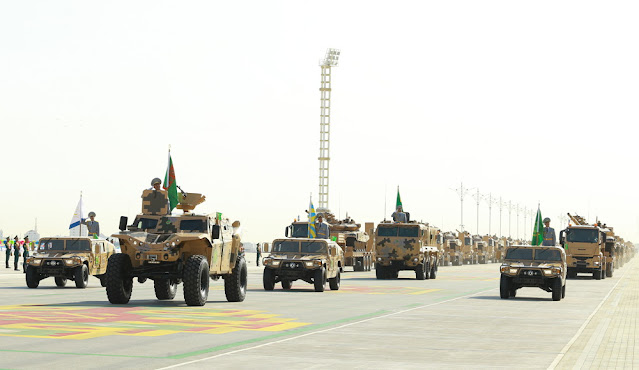By Stijn Mitzer and Joost Oliemans
The future prospects of business with Turkmenistan must have looked promising for Russian arms manufacturers in the late 2000s, with a steady stream of orders for armoured fighting vehicles (AFVs), helicopters and naval ships pouring in. However, after initially mostly relying on Russia to modernise its armed forces, orders for more Russian armament from Turkmenistan quickly began to dry up. Instead, Turkmenistan diversified its arms acquisitions to include a myriad of other nations' arms suppliers, at the cost of arms manufacturers in Russia and Ukraine.
This sudden shift in acquisition strategy mostly appears to have put an end to Turkmenistan's plans to modernise and partially replace the Soviet-era equipment of its mechanised forces with Russian T-90S MBTs and BMP-3 infantry fighting vehicles (IFVs). Only small numbers of these would ultimately be acquired, with the country's new defence doctrine seemingly favouring wheeled AFVs, mostly infantry mobility vehicles (IMVs) purchased from countries such as Turkey, Saudi Arabia, Israel, the UAE, Austria and Belarus.
Nonetheless, Turkmenistan's 30th anniversary of independence parade in September 2021 revealed that Turkmenistan has turned to Russia for the supply of armament once more. The KamAZ-63968 Typhoon mine-resistant ambush protected vehicle
(MRAP) made its first appearance in the ranks of the Turkmenistan Army during the parade. [1] Unfortunately, any information on the actual quantity of vehicles acquired is lacking, and it is possible that numbers have so far remained limited to an initial batch for operational tests.
The Turkmen Ground Forces is the first confirmed export customer of the KamAZ-63968, which made its combat debut in Syria in 2016 while deployed with Russian forces. Contrary to most other MRAP designs worldwide, the Typhoon
does not feature any armament, although it can be equipped with a 12.7mm remote weapon station (RWS) depending on the customer's requirements. [2] Nonetheless, neither the Russian military nor the Turkmen Army so far appears to have purchased any RWS for its fleet of Typhoons.
 |
One of the few BMP-3 IFVs delivered to Turkmenistan in the late 2000s or early 2010s on parade in Ashgabat. |
The ergonomics of the KamAZ-63968 have also been significantly improved compared to earlier Russian AFVs. Video cameras are installed at the front, rear and sides along of
the MRAP, amking it possible to observe the general vicinity around the KamAZ-63968 without having to leave the safety of the vehicle, as well as to control the armored
vehicle in case the windshield has become bullet-riddled. The sixteen passengers embark and disembark through a ramp at the rear of the vehicle, and a total of seven hatches are mounted on the roof to enable emergency evacuations.
 |
A Turkmen CombatGuard 4x4 IMV of Israeli origin is followed by three Chinese-made Dongfeng EQ2050s while a KamAZ-63968 MRAP is seen further to the rear. |
[1] Turkmenistan’s Parade Analysis: What’s New? https://www.oryxspioenkop.com/2021/10/turkmenistans-parade-analysis-whats-new.html
[3] Russian Company Delivers Ansat, Mi-17-1W Ambulance Helicopters to Turkmenistan https://business.com.tm/post/6900/russian-company-delivers-ansat-mi171w-ambulance-helicopters-to-turkmenistan
Recommended Articles:

.png)







